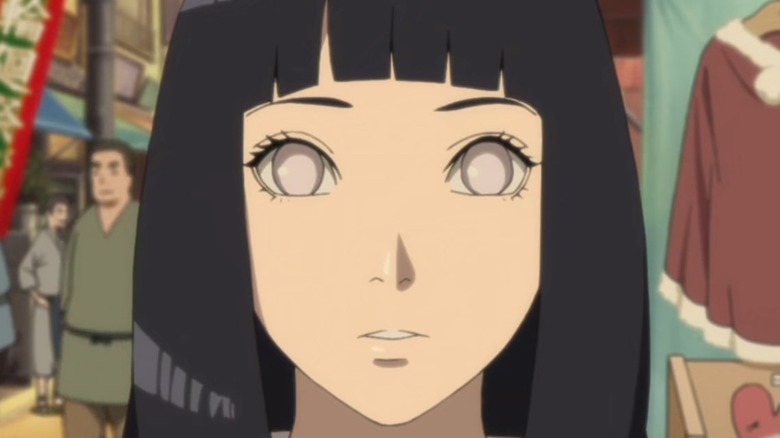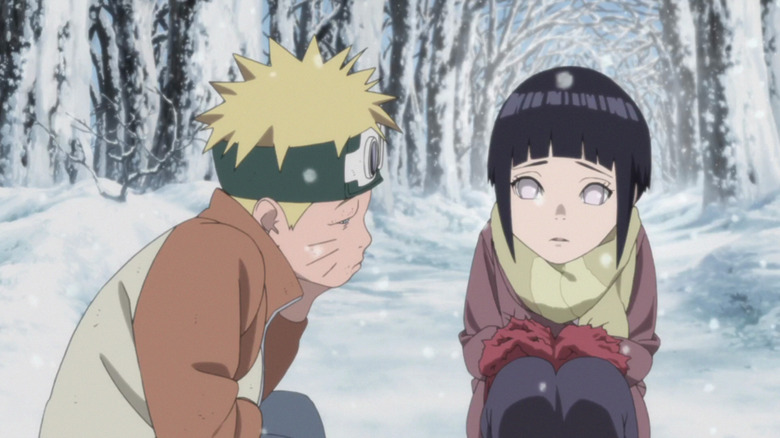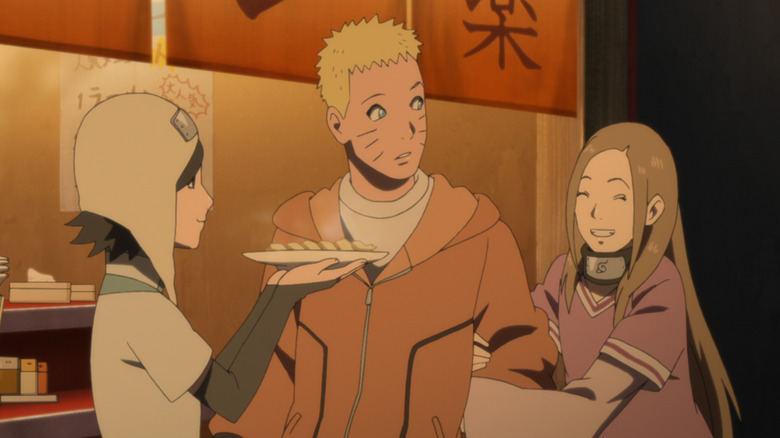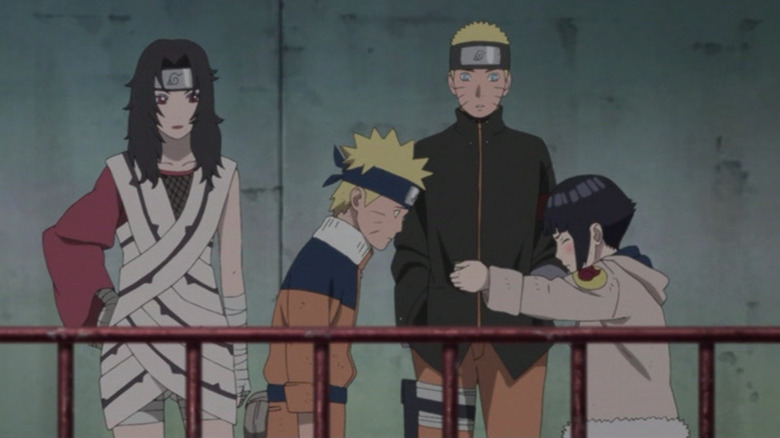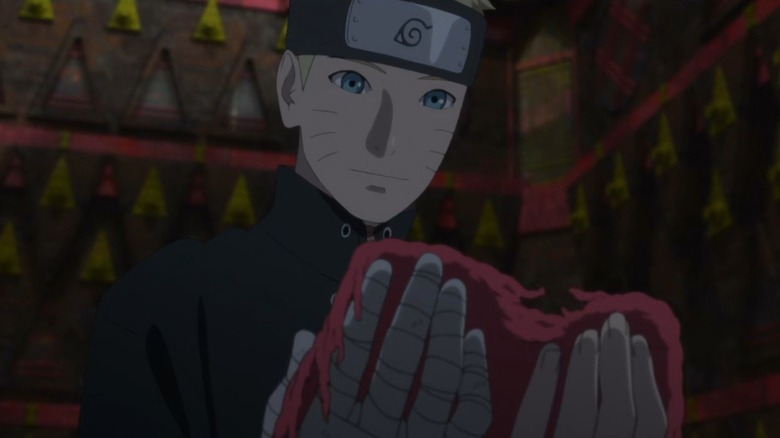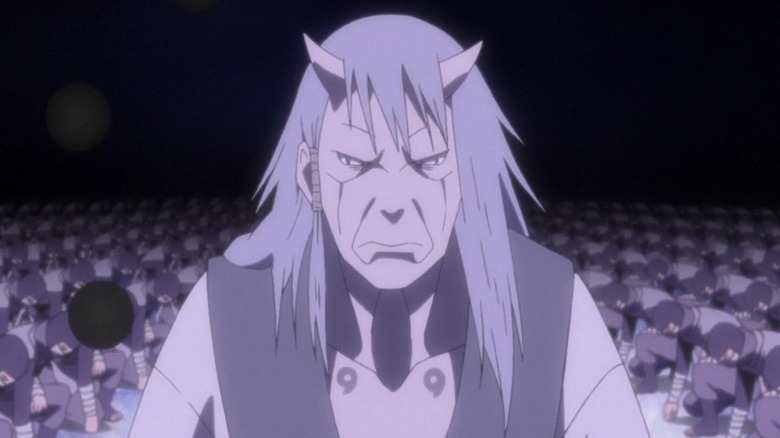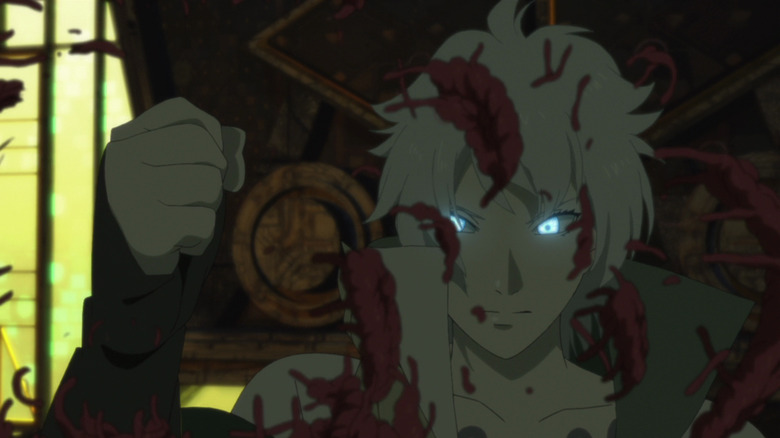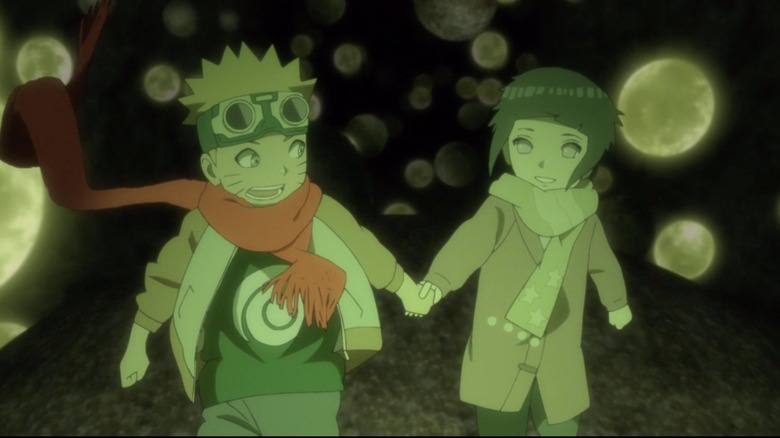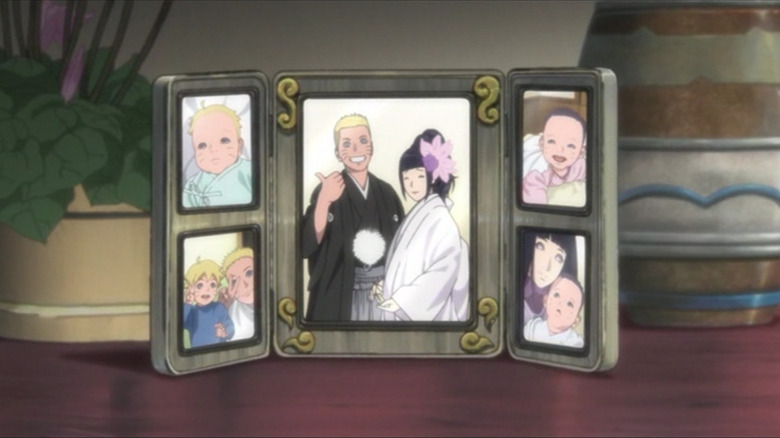The Ending Of The Last: Naruto The Movie Explained
On December 6th, 2014, "The Last: Naruto the Movie," was released in theaters in Japan. The film, billed as the final theatrical release in the "Naruto" series, became the highest-grossing film in the franchise and wouldn't be topped until the 2015 release of "Boruto: Naruto the Movie." So, no, "The Last" was not actually the last "Naruto" movie.
Made as a final hurrah to the original "Naruto" generation, as well as a tie-in to the anticipated final chapter of the manga, "The Last: Naruto the Movie" is a peculiar movie for a shounen series for young boys. While the film continues the exhilarating action one would expect from "Naruto," the heart of the story is all about the blossoming romance between Naruto Uzumaki and his longtime admirer, Hinata Hyuga.
Shounen series, in general, focus more on action than romance. Masashi Kishimoto, the creator of "Naruto," has admitted his discomfort at writing romance — so much so that he wasn't sure he would be able to handle Naruto and Hinata kissing at the end of the movie. Thanks to the film's late director, Tsuneo Kobayashi, Maruo Kyozuka as screenplay writer, and all the talented animators at Studio Pierrot, "The Last: Naruto the Movie" was able to bridge the gap between Chapter 699 and the Chapter 700 epilogue by showing how Naruto and Hinata finally came to be.
For anyone who might have been confused about certain details of the film, or were out of the loop about where the "Naruto" world was before the film, here's a rundown of important plot points relating to the conclusion of "The Last: Naruto the Movie."
Love at first sight
"The Last: Naruto the Movie" takes viewers to the very beginning — twice.
The first cold opening encapsulates the world history of "Naruto" through a slick, CG-animated montage that resembles an ink wash painting; the second cold open shows Hinata's first encounter with Naruto as a child.
Before her enrollment in the Academy, a young Hinata is seen being bullied by three boys over her Byakugan and starts to cry after one calls her a monster. Enter a young Naruto, who attempts to save Hinata by using his signature Shadow Clone Jutsu on the bullies. Unfortunately, at this part of the story, Naruto is just a klutz and only manages to summon two pipsqueak clones of himself. Before Naruto can attempt a take-two on his jutsu, the bullies take him out with one punch and proceed to destroy the red scarf that he is wearing.
Even though Naruto fails to defeat the bullies, his intrusion does stop them from harassing Hinata. Hinata expresses her gratitude to Naruto but Naruto essentially says no biggie and runs off. When Iruka Umino asks the class who they would want to be with if the world were to come to an end by, oh, let's say the moon crashing down to earth "Majora's Mask" style, Hinata writes in Naruto's name, marking the beginning of her affection for him.
No longer a class clown
One of the biggest status quo changes in "The Last: Naruto the Movie" is that Naruto is no longer seen as the class clown, looked down on by adults and his peers.
Two years after his successful intervention in the Fourth Great Ninja War, young adult Naruto is now seen as a local hero. He not only has a legion of fangirls at the Village Hidden in the Leaves, he has also developed a following from other villages as well (some of which travel just to take photos of him).
As one would expect from the knuckle-headed ninja, Naruto is completely oblivious to his newfound status as a heartthrob for young girls, often looking confused at their admiration for him and being baffled when they bring him lavish presents. It's a great change of pace to see Naruto learning to live life as a celebrity while also building the case as to why Naruto has been so dense about Hinata's crush on him.
Understand the concept of love
It's rare to see a shounen series like "Naruto" dedicate so much time and effort in developing a romance between its two lead characters, let alone an entire movie, and "The Last" doesn't just show viewers the steps that led to the marriage of Naruto and Hinata, it also answers the question of why Naruto has never been able to recognize Hinata's true feelings until now.
Yes, Hinata's shy, reclusive personality plays a part in her delayed declaration of love towards Naruto, but he is at fault as well. However, it's not out of malice that Naruto failed to recognize Hinata's true feelings for him but out of ignorance. The film spells out — bluntly with Sakura Haruno's conversations with Hinata and Naruto — that because Naruto never experienced the love of friends and family when he was growing up, he was unable to express or detect any kind of love that went deeper than his appetite for ramen.
The genjutsu lake scene is when the hammer finally hits the nail on the head, as the merging memories between Naruto and Hinata allow Naruto to sit back and observe crucial moments between him and Hinata, while also seeing things from her point-of-view. this is particularly true when Hinata writes his name on Iruka's once hypothetical assignment on who she would want to be with if the world came to an end.
The red scarf
The most important item in "The Last" is one often taken for granted, despite the hard work it takes to make one: a scarf. A red scarf, to be exact.
Naruto losing his red scarf to the bullies he was trying to protect Hinata from is how the two first met. The red scarf is how Naruto was able to see Hinata's memories and witness her true feelings for him when they were submerged in the lake of genjutsu. Despite the countless times it's destroyed throughout the film, Hinata continues to knit and reknit a red scarf for Naruto, in the hopes of replacing the one he lost as a child, and perhaps using it as a declaration of her feelings towards him. Even when only a shred of it remains near the end of the movie, Naruto happily accepts what remains, channeling his love and admiration for her through it to defeat Toneri Ōtsutsuki.
As Naruto says in the movie, it takes a long time to knit someone a scarf. Hinata's relentless knitting for Naruto despite all the setbacks is a great reflection of her love and loyalty to him. The red scarf is also a symbolic imagery of the Red Thread of Fate (often called the Red String of Fate); an East Asian belief of an invisible red cord tied around a finger of those destined to be together. The idea behind Hinata knitting a red scarf for Naruto came from Kishimoto, as it was something his wife has actually done for him.
The Ōtsutsuki Clan
The Ōtsutsuki Clan are an ancient group of god-like extraterrestrial beings, responsible for the lineage of the Uchiha, Senju, Uzumaki, and Hyuga clans. They're a parasitic species that feeds off the life force of a planet in order to continuously evolve until they reach divinity.
For the conquest of Earth, the plan was for Kaguya Ōtsutsuki to sacrifice herself to the Ten-Tails sapling so that the God Tree could grow and produce the chakra fruit for Isshiki Ōtsutsuki to take back to the clan. Kaguya, however, betrayed Isshiki and her clan and eventually devoured the chakra fruit herself. Her newfound powers made Kaguya the first chakra user on Earth, ceasing all of mankind's conflicts to attain world peace.
She later became pregnant with two boys, Hagoromo and Hamura, who were born with chakra of their own. The paranoia of her clan coming back for vengeance, as well as the corrupted properties of the chakra fruit, changed Kaguya from a godsend to humanity to a demonic monster. Kaguya's obsession with possessing all the chakra led to her sons sealing her away, after she integrated herself with the God Tree and became the Ten-Tails.
Hagoromo and Hamura used the Six Paths — Chibaku Tensei technique to transform the Ten-Tails into the core of the moon. Hamura assumed leadership of the Ōtsutsuki clan and stayed on the moon to watch over the remains of his mother. Meanwhile, Hagoromo stayed on Earth to spread chakra to humanity, teaching them the ways of ninshū.
Toneri Ōtsutsuki
Toneri Ōtsutsuki is a descendant of Hamura Ōtsutsuki and the last remaining survivor of the Ōtsutsuki Clan.
He detests mankind for their weaponization of chakra, and following the end of the Fourth Great Ninja War, decides to end humanity by having the moon crash into Earth. He kidnaps Hanabi Hyūga, the younger sister of Hinata, for her Byakugan and uses them to form the Tenseigan. He then kidnaps Hinata to force her into becoming his bride. His despicable actions are motivated by what he believes to be the decree of his ancestors, unaware that the decree Hamura made centuries ago was misinterpreted.
In the aftermath of his defeat by Naruto, Toneri is confronted with the harsh reality of his ancestor's actual decree to protect humanity — not destroy it. To atone for his sins, Toneri decides to stay in solitude on the moon, despite Naruto and Hinata's invitation to live on Earth, and promises the moon will come in contact with Earth again. Despite being the final antagonist of the original "Naruto" movie series, Toneri is light on characterization and motivation. However, the novel adaptation of the movie sheds light on some of his questionable actions.
For starters, Toneri's obsession with Hinata actually began when he was a child, back when his father would occasionally take him down to Earth and encouraged him to marry Hinata when they observed the Hyūga clan. There's also more focus on Toneri's isolation, which grew exponentially following the death of his father. Hinata determined that the reason why Toneri had such a black-and-white view on good and evil is because he was surrounded by the Ōtsutsuki clan's autonomous puppets, who lacked the free will to challenge him on his worldview.
The book further cements a lonely parallel between Naruto and Toneri, with Naruto saying that he could have ended up as Toneri if he didn't have Hinata and his friends to keep him company. Naruto's sympathy for Toneri explains why he couldn't let him die after Toneri was overwhelmed by his own power, and was in turn nearly burnt to a crisp by the sun.
Walking down memory lane
After stopping the moon from colliding with Earth and helping Toneri see the error of his ways, Naruto and Hinata return home through the same cave that was filled with bubbles of genjutsu. Before they leave, Naruto tells Hinata that the scarf he was wearing earlier was made by his mom before she passed away, which brought a great sense of relief to Hinata, who feared it was a present from one of Naruto's admirers.
As they journey through the portal hand-in-hand, images of Naruto and Hinata's past and present selves are shown, one of which has Naruto wearing a restored version of Hinata's red scarf. Naruto tells Hinata to hold on tight, as he uses his chakra to fly out of the cave, where the couple share their first kiss, against the background of the moon. What follows are the end credits that show the wedding day of Naruto Uzumaki and Hinata Hyuga. If you want to actually see how Naruto and Hinata's wedding came to be, the "Naruto: Shippuden" anime series fills the gap before adapting the final chapter of the "Naruto" manga.
Post-credit scene
The post-credit scene flashforwards to an older Naruto, seen practicing outside, while Hinata knits a new red scarf. Then, the couple are greeted by their children, Boruto Uzumaki and Himawari Uzumaki, who engage in a playful snowball fight with their parents as the camera turns to a portrait of Naruto and Hinata on their wedding day and with their newborn children.
It's a significant moment in the series, not only because this was the first time Boruto and Himawari made their animated appearance (and far from their last), but it's a scene that shows how much Naruto's life has changed for the better. Once an orphan with no one to come home to, Naruto is now a married man with kids he can greet with arms open wide. Of course, becoming a father is far more complex than that, as seen in "Boruto: Naruto the Movie" and "Boruto: Naruto Next Generations."
"The Last: Naruto the Movie" may mark the end of the original generation of "Naruto," but the "Boruto" sequel series keeps its legacy alive with new friends, adventures, and easter egg tributes to the franchise's rich history.
